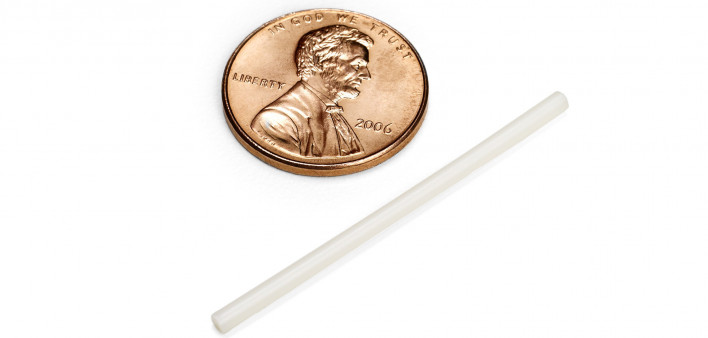An experimental islatravir implant that can be replaced just once a year could one day be a convenient new option for HIV pre-exposure prophylaxis (PrEP), according to early study results presented this week at the virtual Conference on Retroviruses and Opportunistic Infections (CROI).
Daily oral PrEP using Truvada (tenofovir disoproxil fumarate/emtricitabine) or Descovy (tenofovir alafenamide/emtricitabine) and cabotegravir injections given every other month are highly effective at preventing HIV. But longer-acting methods could be an attractive option for some people at risk for HIV.
Randolph Matthews, MD, PhD, of Merck, presented the latest findings from a study of a long-lasting islatravir subdermal implant for HIV prevention.
Formerly known as MK-8591, islatravir is a first-in-class nucleoside reverse transcriptase translocation inhibitor with multiple mechanisms of action. It has a long half-life in the body, suggesting it has the potential to be taken once weekly for HIV treatment or once monthly—or less—for PrEP.
A prior study showed that weekly oral doses of islatravir protected monkeys exposed to a hybrid simian-human virus similar to HIV. As reported at the recent HIV Research for Prevention conference, islatravir pills were well tolerated and reached levels adequate for protection in humans. At CROI, researchers reported that a 60-milligram dose maintains protective drug levels for a month, with some forgiveness for delayed dosing; this dose was selected for further evaluation in Phase III trials.
At the 2019 International AIDS Society Conference on HIV Science, Matthews presented the first data from a Phase I clinical trial of a prototype islatravir implant, showing that drug levels remained above the threshold found to be protective in monkeys for at least 12 months.
At CROI, Matthews presented results from a follow-up study of an updated version of the implant. While the older implant contained only islatravir and a polymer that releases small amounts of the drug over time, the next-generation version is easier to manufacture and includes a barium tracer that makes it visible on an X-ray, in case it migrates away from the insertion site. The implant, about the size of a matchstick, is administered using the same applicator as the widely used Nexplanon contraceptive implant.
This study included 36 men and women at low risk for HIV. Twenty-four of them received implants containing 48, 52 or 56 milligrams of islatravir, which were inserted under the skin of the upper arm and left in place for 12 weeks. For each dose level, eight people received islatravir implants and four received matching placebo implants. They were followed for an additional eight weeks after the implants were removed.
Regardless of dose, levels of islatravir triphosphate (the active form of the drug) reached and remained above the target effective threshold for 12 weeks and then began to decline. The highest-dose implant produced protective drug levels for about 16 weeks—four weeks after removal of the implant—while the lower doses fell below the threshold sooner. The researchers projected that the 56-mg implant should release adequate levels of islatravir for almost all individuals for more than 52 weeks. This will offer some forgiveness if replacement is delayed, Matthews said.
The implant was safe and generally well tolerated. About two thirds of the participants reported at least one implant site reaction, including redness, tenderness, pain, itching or induration (hardening of tissue), but all were all mild to moderate. These side effects were more common with the islatravir implants compared with the placebo implants. There were no serious adverse events and no discontinuations due to adverse events.
These findings, the researchers concluded, support continued development of islatravir implants as a potential once-yearly PrEP option. Merck indicated that it plans to start a Phase II trial enrolling people at low risk for HIV to further evaluate the implant.
As is the case with contraception, having a wider range of options makes it easier for more people to find one that fits into their life.
“It’s not that this will be ’the answer,’ but it will be another approach,” said Sharon Hillier, PhD, of the University of Pittsburgh, who moderated a CROI press conference about the findings. “Some people will want implants, some will want daily pill, some will want every-other-month injections. With a higher number of options, we have a better chance of impacting the epidemic.”
Islatravir is also being studied for HIV treatment. A combination of once-daily islatravir plus doravirine (Pifeltro) demonstrated good efficacy in a Phase IIb trial, but new data presented at CROI suggest that doravirine will not be a suitable partner for less frequent dosing. Islatravir plus Merck’s experimental non-nucleoside reverse transcriptase inhibitor MK-8507 maintained HIV suppression with once-weekly dosing, and this combination is being evaluated in larger studies. Gilead Sciences’ capsid inhibitor lenacapavir may also be a potential partner for a long-acting treatment regimen.
Update: On March 15, Gilead and Merck announced that they will collaborate to jointly develop long-acting combinations of lenacapavir and islatravir for HIV treatment.
Click here to read the CROI abstract.
Click here for more news about PrEP.







Comments
Comments